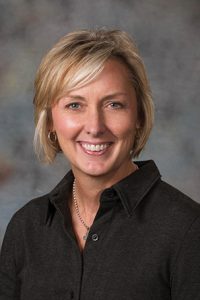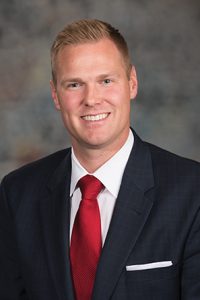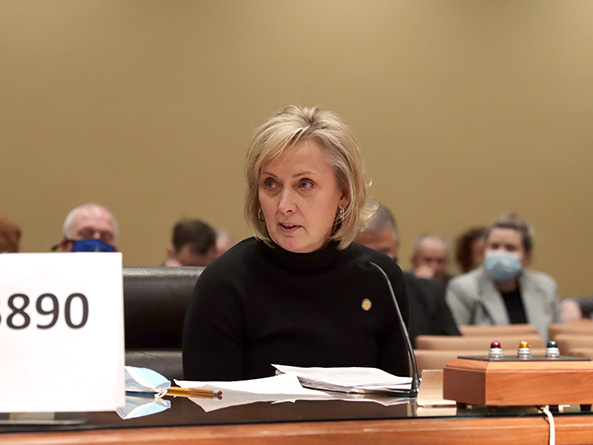School funding formula “revamp” considered
Nebraska would set aside a portion of its sales tax revenue to fund a new form of state aid to public schools under a pair of proposals heard by lawmakers this week.

In a Jan. 25 hearing, Fremont Sen. Lynne Walz, sponsor of LB890, said the bill would “revamp” the Tax Equity and Educational Opportunities Support Act, which distributes state aid to Nebraska’s 244 public school districts.
Under her proposal, each district would receive education stabilization base aid (ESBA) paid from a new trust fund, which Walz called a “rainy day fund for education.”
“While our current economic situation is good, we all know that in lean times, TEEOSA has been cut to balance the budget, therefore increasing property tax[es],” she said. “By saving money in the good years, we are preparing to support schools in lean years better than we ever have been able to do in the past.”
Districts would receive $550 in ESBA per student for school fiscal year 2022-23 and $1,100 per student in 2023-24. Beginning in 2024-25, the amount would increase by a basic allowable growth rate of 2.5 percent, Walz said.
The bill also would increase the allocation of state income taxes to school districts from the current 2.23 percent to 20 percent in 2023-24.
To ensure the additional state aid results in property tax relief, Walz said, LB890 would decrease the local effort rate — a component of the school funding formula that uses property valuation to determine how much a district can contribute in property taxes to fund a school — from $1 to 75 cents.

LB891, a companion bill introduced by Sen. Brett Lindstrom of Omaha, was heard Jan. 26 by the Revenue Committee. It would modify school levy authority and adjust the state’s tax code to fund the additional aid.
In addition to allocating a portion of state sales and use tax proceeds to the ESBA trust fund, Lindstrom said, the bill would end the distribution of refundable income tax credits under the Nebraska Property Tax Incentive Act and repurpose that money to fund TEEOSA.
The credit, currently funded at $548 million, is based on the amount an eligible taxpayer paid in property taxes to their school district during the previous year.
Chip Kay, director of finance and human resources for Columbus Public Schools, testified in support of both bills. Walz credited Kay and Columbus superintendent Troy Loeffelholz with creating the proposals’ initial framework.
Kay said decreasing the local effort rate would reduce school districts’ property tax asking by more than $725 million. The state would replace that funding with ESBA and the increased income tax allocation, he said.
When fully implemented, Kay said, the bills would shift the balance of school funding from a current 39/61 percent split between state and local sources to a 58/42 percent split. He said 242 of the state’s 244 school districts would receive additional state aid under the plan.
Mark Fritch, superintendent of Nebraska City Public Schools, testified in support of LB890. He said the district’s low property value prevents it from generating enough revenue to meet its basic needs under the current state aid formula.
Fritch said the bill would be a “game changer,” allowing the district to reduce its levy from the maximum and set aside money to upgrade facilities and address changing needs.
Jami Jo Thompson, superintendent of Norfolk Public Schools, also testified in support of the Walz proposal. When fully implemented, she said, it would allow her district to decrease its general fund levy by enough to reduce its property tax asking by approximately $12 million.
Thompson said LB890 also would reduce the discrepancy in levies between Norfolk and its neighboring districts. Norfolk’s higher levy places an undue burden on its property taxpayers, she said, particularly farmers.
Jack Moles testified in support of LB890 on behalf of the Nebraska Rural Community Schools Association. He said it would result in many more schools receiving equalization aid, which is intended to cover the difference between a school’s resources and its needs, and allow schools to reduce their property tax askings.
He suggested, however, that the bill include a component to ensure that every district receives at least 20 percent of its basic funding from the state.
Testifying in opposition to both bills was Cheryl Logan, superintendent of Omaha Public Schools. She said the funding mechanisms proposed in LB891 would not cover the cost of additional state aid over the long term.
For districts like OPS that rely heavily on state aid, Logan said, LB890 would lead to greater unpredictability than the current school funding formula.
“Even if this body were able to come up with the funds in year one or year two,” she said, “the Legislature’s long history of balancing the state budget by reworking TEEOSA suggests such an approach is not sustainable.”
Monty Stoddard testified in opposition to LB891 on behalf of the Nebraska Cattlemen, Nebraska Farm Bureau and several other agricultural organizations. Under LB890 and LB891, he said, agricultural landowners would trade the LB1107 credit’s 29 percent reduction in property taxes paid for only a 19 percent reduction.
In the first year, Stoddard said, the proposals would direct 93 percent of total state aid to 86 currently equalized school districts. He said 80 percent of new state aid would go to those equalized districts.
“While better than the current distribution,” Stoddard said, “it appears that distribution of state aid would remain unproportionately weighted to schools which already get the bulk of the state aid.”
Tiffany Friesen Milone gave neutral testimony on LB891 on behalf of OpenSky Policy Institute. She said reallocating funding for the LB1107 credit to TEEOSA would move Nebraska closer to a middle rank in terms of state support for education rather than its current rank of 49th.
Friesen Milone said OpenSky is concerned about the proposal’s long-term sustainability, however, because it does not provide a new source of revenue to fund the additional aid.
The committees took no immediate action on either bill.


